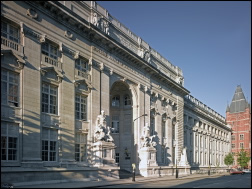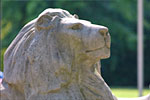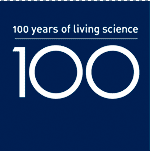Keith Viewing
(Applied Geochemistry Research Group, 1960-63)
Keith remembers the acheivements of the Applied Geochemistry Research Group
The core yard glittered at noon, but there was no sign of drill-core or of the enthusiasts associated with it. The group from geology at the great Mufulira Copper Mine, Zambia, were found crowded in a small room with a rough wooden bench and a sink. Silence; a slight man, topped by dark hair and vivid brown eyes, shook two handfuls of test tubes back and forth from chest to shoulder, and the only sound was the swish of bubbles in the tubes and the gasp of breath from John Webb. The magic continued for two minutes exactly and that was the start of a strong bond with Rhodesian Selection Trust. That company was formed by Sir Alfred Chester Beatty to exploit the copper deposits, and joint ventures with Anglo American Corporation on all six mines achieved a yield of 650 000 t copper, pa.
The test-tubes contained a green organic reagent, a buffer to control the pH, and a sample of soil. There were all shades from green to pink as we saw for the first time, a simple chemical analysis of copper in the range from say 25 to 500 ppm. This was magic indeed, a practical and cheap field method to reach beneath the overburden and indicate hidden deposits in the weathered rock, say 15 m below. Some of the ideas were from antiquity, many from a steady trickle of translations from Russia, but the inspiration was at first from Herbert Hawkes of the U.S. Geological Survey in a test of drainage sampling in New Brunswick.
 Back at the R.S.M. John Webb had built a research group of geologists supported
by an unusual chemical analysis laboratory, led by Ronald Stanton. The newcomer
simply joined the group, studied the literature and trained in trace metal
analysis for about five months. Much depended upon whether the method tested in
the laboratory would work in the field, whether rainforest or the outback, for
each project was designed to discover the extent of the geochemical dispersion
from a mineral deposit, or small mine. The student mapped the deposit and the
potential extensions, and collected and prepared the samples. A rudimentary
laboratory was arranged under a tree or canvas, the balance and primus stove
were levelled, and the reagents and standards prepared on a rudimentary table.
The target for the first eight years until AAS was re-invented and practical by
1963, was to analyse 100 samples per man/day. You had to get that right, you
and your doze
n or so porters who were away for six months at a time. You were on your own
and no need for any additional motivation.
Back at the R.S.M. John Webb had built a research group of geologists supported
by an unusual chemical analysis laboratory, led by Ronald Stanton. The newcomer
simply joined the group, studied the literature and trained in trace metal
analysis for about five months. Much depended upon whether the method tested in
the laboratory would work in the field, whether rainforest or the outback, for
each project was designed to discover the extent of the geochemical dispersion
from a mineral deposit, or small mine. The student mapped the deposit and the
potential extensions, and collected and prepared the samples. A rudimentary
laboratory was arranged under a tree or canvas, the balance and primus stove
were levelled, and the reagents and standards prepared on a rudimentary table.
The target for the first eight years until AAS was re-invented and practical by
1963, was to analyse 100 samples per man/day. You had to get that right, you
and your doze
n or so porters who were away for six months at a time. You were on your own
and no need for any additional motivation.
During this early phase of the work, John Webb, John Tooms and Ron Stanton had focussed on copper, cobalt and vanadium in Zambia; arsenic, beryllium and chromium in Zimbabwe, lead and tantalum in Nigeria and lead in Tanzania, and manganese in Guyana. Studies of geochemical dispersions and the analytical methods were well advanced in the U.S. Geological Survey and in Russia, where a huge investment was in progress, but translations were rare. Colonial Africa of the times was untouched, and there was the opportunity.
The philosophy was developed too. Deposits of precious and base metals are often within a mineral province and a geochemical province might be found to skirt both, and include for example deposits blind at the surface. The advantage therefore, was inexpensive low-density drainage sampling and multi-element chemical analysis to discriminate between the geochemistry of the bedrock and discrete metal deposits. Arc -emission spectroscopy was quick, inexpensive, and semi-quantitative so that much depended upon the interpretation of the results.
Small and large scale tests in Zambia revealed traps for the unwary. Significant differences were found between the total and part-extractable metal contents of weathered rocks, and a huge bias could result from the matrix effects of silica and iron in spectroscopy. But successful and large scale tests covered huge tracts of Central Sierra Leone where the rainforest obscures most of the ancient rocks that have a potential for gold, chromium, copper and nickel.
That was an exciting time, and more was to come as John Webb returned from lunch with Sir Alfred Chester Beatty on another well remembered day. A mutual interest was found in the effects of trace metals and animal health. The regional geochemical maps of England, Wales and Northern Ireland were planned, and patterns of cobalt, copper, molybdenum and selenium were of real concern to the health of animals. Arsenic, lead and selenium were of serious concern to man, there was a steady demand for new reservoirs and the catchments would need to be planned accordingly. The scope was huge and environmental geochemistry took the lead.
Next and much more difficult, were the studies of metal dispersions on the ocean floor and the search through a cover of arid and even desert terrain using gas for detection. For example, how do you search on the surface of an active sand dune that obscures a mantle of leached soil and weathered rock that could be 100 m thick, or more? Alternatively, how do you deal with intensely leached iron oxide found as a few grains on the surface that could indicate a great nickel-copper deposit below?
And all of that from a few small rooms on the 4th Floor of the Royal School of Mines; a leader in the field that moved with the times. At first a few test tubes in the bush, then the use of progressively more modern but practical equipment in a base laboratory. The fun of immediate results was lost, but now rigorous standard samples controlled the results and interpretation became an art beyond statistics, but of absorbing interest to the few.
Bravo for John Webb and his team, bravo for John Sutton, Dean of the RSM, and for Imperial College that encouraged the closest connection with industry
© 2007 Imperial College London

Through the first decade of the twenty-first century the campaign seeks to philanthropically raise £207 million from Imperial’s alumni, staff and friends, and donations from charitable foundations and industry.
Where your support can make a differenceGive now

Imperial’s Centenary Year provides an opportunity to recognise and celebrate members of the Imperial community.
View staff and student portraits
